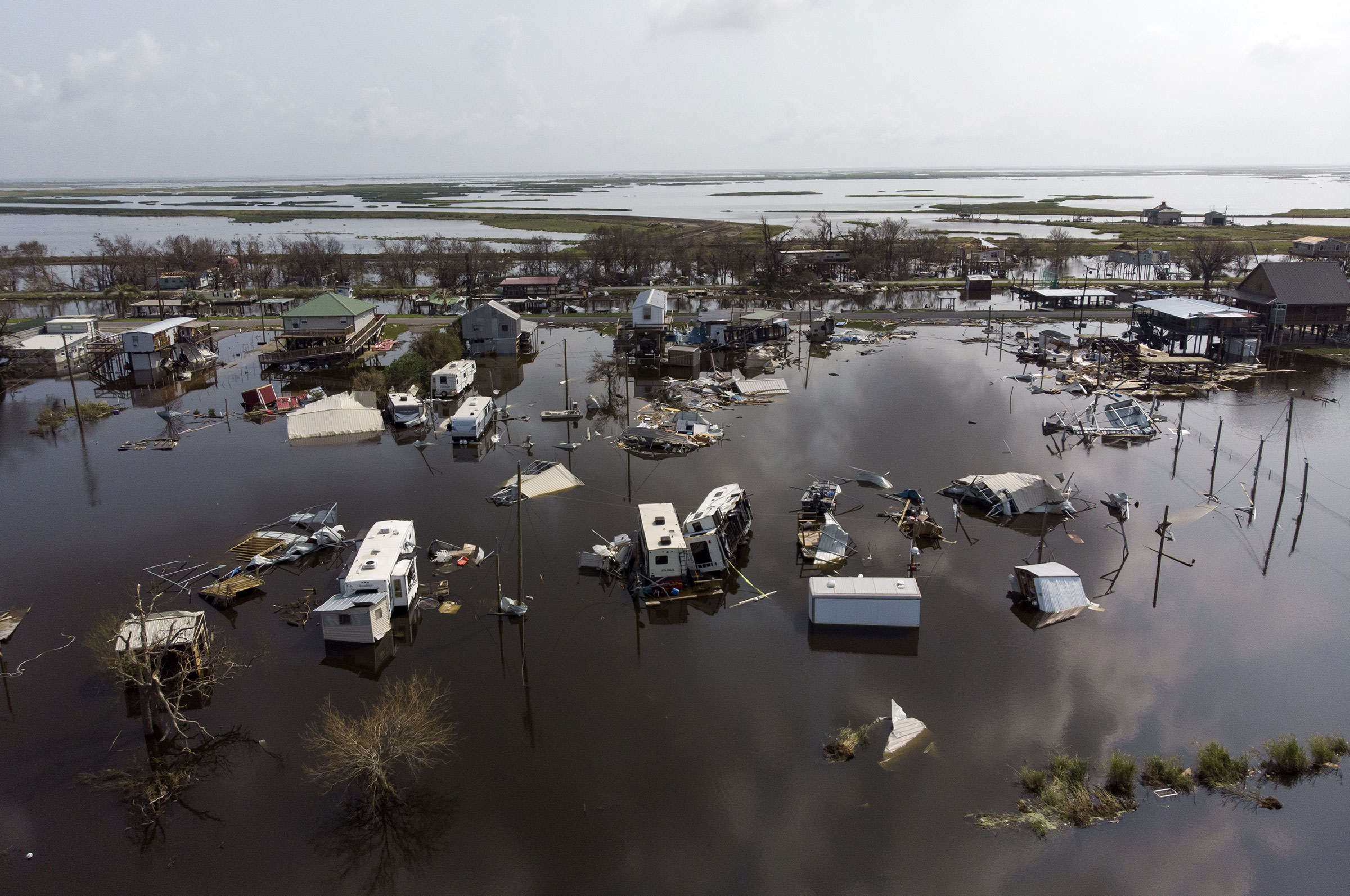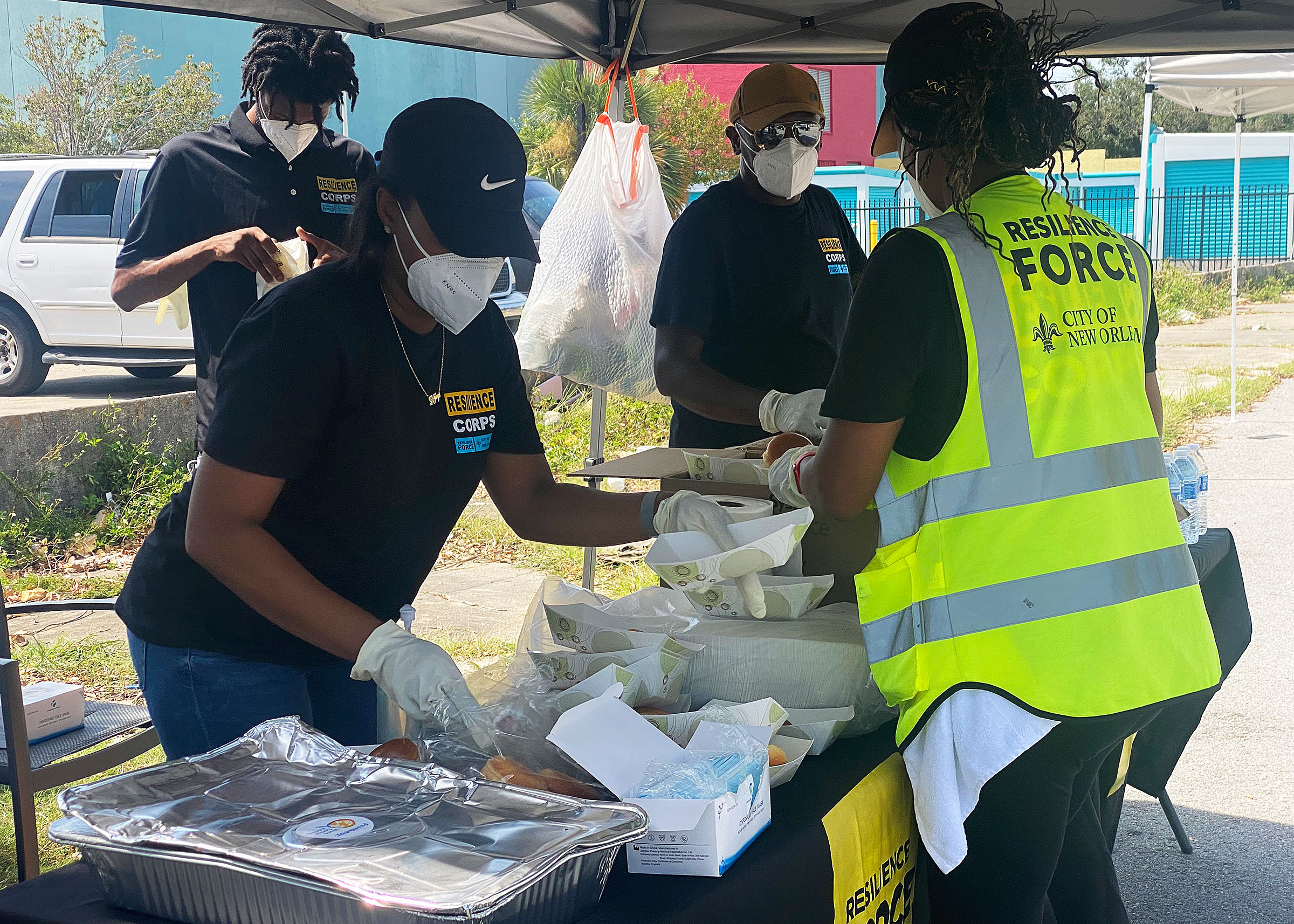
When Hurricane Ida hit New Orleans in early September, Tonya Freeman-Brown made the difficult decision to stay in the city. The 53 year-old and her family sheltered in an old brick hotel in the downtown area, watching fierce winds of up to 150 mph pelt rainwater at the windows, and remembering the destruction wrought by Hurricane Katrina, 16 years earlier to the day. It was stressful, but Freeman-Brown had a job to do, she says. “We’re no match for nature, but this is what we’ve trained for. This is what the Resilience Corps was built for.”
Like firefighters put out fires, and waste collectors keep the city clean, the job of the New Orleans Resilience Corps is to help the city be resilient to shocks, crises and climate change. Launched by the city in October 2020, as a pilot to run for two years, the corp’s 40 workers were mainly people who had lost jobs in the hospitality industry during the pandemic, who are now on full-time contracts, starting at $12 an hour with a path to an $18 an hour wage. Freeman-Brown joined after losing her work as a corporate massage therapist at an insurance company. The corps spent much of the last year working to support the city through COVID-19 and get people vaccinated.
Hurricane Ida is the first climate disaster that the corps has confronted. Though the sophisticated system of levees, pumps and flood barriers built in the wake of Katrina protected the city from water damage, the storm’s high winds battered the city, killing 13 people there and toppling thousands of power lines and hundreds of substations. The lights remained off across most of New Orleans for a week, with at least 10% of electric customers still without power nine days later. The city’s hospitals, already struggling with some of the highest COVID-19 case rates in the country, scrambled to treat a wave of heat and storm-related emergencies.
Ida has highlighted the disproportionate impact that climate disasters have on lower income residents and elderly or disabled people, says LaTanja Sylvester, program coordinator of the NOLA Resilience Corps. “This really is a tale of two cities. There are individuals who could evacuate, that are out on beaches running around with their kids,” she says. “And then there are families that are stuck in their homes because they could not afford to travel or pay for accommodation to evacuate.” Those that couldn’t evacuate were left stranded in 90°F-plus heat and humidity, with no internet, no cold water and food rotting in their fridges.
The corps aims to help those more vulnerable NOLA residents bounce back from a crisis as fast as more privileged groups. Since it became safe to go outside, Freeman-Brown and her colleagues have been delivering ice to homes, checking in on people who couldn’t evacuate, and serving up food donated by local restaurants to thousands left hungry by broken refrigerators. In the coming weeks, when power is fully restored, the team may pivot to helping those whose homes were damaged by the winds to rebuild or file insurance claims, or support those who catch COVID-19 during this period—whatever is needed.

The NOLA resilience corps’ work after Ida is a key test for a model that advocates hope to see repeated in cities across the country as climate change makes extreme weather events more common and more widespread. According to analysis published Sept. 4 by the Washington Post, in the last three months, nearly one in three Americans have experienced a weather disaster in their county. “Each of these disasters makes us realize what kind of new infrastructure we need, as with the levees in New Orleans,” says Saket Soni, the founder of Resilience Force, a national nonprofit labor organization which helped the city set up the corps. “But we also need a new workforce. Because the amount of work is exploding.”
As greenhouse gases build up in our atmosphere, and the earth warms, the global climate is becoming increasingly unstable. The result of that instability is an increasing number of extreme weather events—as the droughts, storms, heatwaves and floods of this summer have reminded us. In August, the World Meteorological Organization published a report finding that weather-related disasters have increased five-fold over the last 50 years, with a seven-fold increase in the economic losses they create.
Resilience Force argues that the increase in destructive events requires a professionalization of the workers who help to keep towns moving during slow-moving disasters like droughts and get them back on their feet in the wake of shocks like storms. Soni began thinking about what he terms the “resilience workforce” in 2005, after he came to New Orleans as a relief worker after Hurricane Katrina. Unemployed people had come from all over—neighboring states, the midwest, Mexico, Peru—he says, to take part in the rebuilding from the storm, which remains the most expensive weather event on record in the U.S. Soni spent the next 10 years working as a labor organizer, representing mainly migrant workers and people doing irregular, temporary jobs in the disaster clean-up sector. In 2015 he founded Resilience Force, a national labor organization that advocates for the rights of around 2,000 of those workers and helps direct them to where their services are needed.
“Volunteerism is really important and we will always need those surges in volunteers, but you can’t sustain it,” Soni argues. “You need a permanent infrastructure of people who are in jobs they can support families with and, given the enormous responsibilities they have, are trained.”
Momentum is building for that idea. Several other cities have launched jobs programs similar to the New Orleans Resilience Corps since the pandemic began. In November 2020, Portland, Maine, announced a 14-person resilience corps to work on transport planning and climate security. In March this year, San Jose, Calif., said it would hire 500 mostly young people to work on the pandemic response, environmental resilience, and disaster preparedness. According to Soni, Resilience Force is in talks with officials from Sonoma County in California, Miami and Houston about launching their own pilots.
For now, most of these programs, including the NOLA corps, rely on funding from charitable foundations and nonprofits. But support is growing among Democrats for the creation of federal funding for corps-style programs, inspired by the Civilian Conservation Corps, the depression-era work relief program rolled out as part of the New Deal. Though not included in the bipartisan infrastructure bill approved by the Senate in August, some kind of climate corps is expected to be a significant part of a $3.5 trillion package focused on climate change and families that Democrats are bringing forward. The Climate Mayors coalition, a bipartisan group of 470 mayors focused on climate, wrote to congress in July advocating for support for 500,000 corps jobs.
The NOLA Corps’ local-focused model is a new frontier for Resilience Force. Unlike its national members, who move from town to town following crises, those in the NOLA Corp are people living long-term in New Orleans, from wards all over the city. That gives the group some advantages over larger out-of-town relief agencies, Sylvester says. “FEMA has to come in, set up, bring in people from out of town that they contract with. But we were on the ground [almost immediately].” Because corps members live and have often grown up in the communities they’re looking after, she adds, they know, for example, where there might be an elderly or disabled individual who can’t leave their home and might be struggling to reach help, she says, or who’s the “go-to” person in town for specific problems.
Being embedded in the community has allowed the corps to reach residents who often don’t know how to access support or resources during a crisis, says corps member Claudio Venancio, 33. Venancio has served on the corps’ Latinx outreach team, spreading information on the COVID-19 vaccine and delivering presentations on hurricane preparedness for Spanish-speaking residents of the city, including undocumented people. “I’m a recipient of DACA so I know firsthand what it’s like to think ‘well I’m not a citizen, so I don’t qualify for any [support],” he says.
Venancio joined the corps when it began in October 2020 after losing work as an actor due to the pandemic. He was promoted to team supervisor in August and says he now expects that resilience work will be his primary career for “the next half” of his life. “This job is so fulfilling to me that, like—I love acting and performing, but this is my career,” he says.
With three months to go in this year’s hurricane season—and the NOAA predicting above average storm activity—Venancio says the corps is bracing for a busy few months. “We’re prepared to aid our city however we can. Nobody’s going to help our community like our own community.”
More Must-Reads from TIME
- Cybersecurity Experts Are Sounding the Alarm on DOGE
- Meet the 2025 Women of the Year
- The Harsh Truth About Disability Inclusion
- Why Do More Young Adults Have Cancer?
- Colman Domingo Leads With Radical Love
- How to Get Better at Doing Things Alone
- Michelle Zauner Stares Down the Darkness
Write to Ciara Nugent at ciara.nugent@time.com